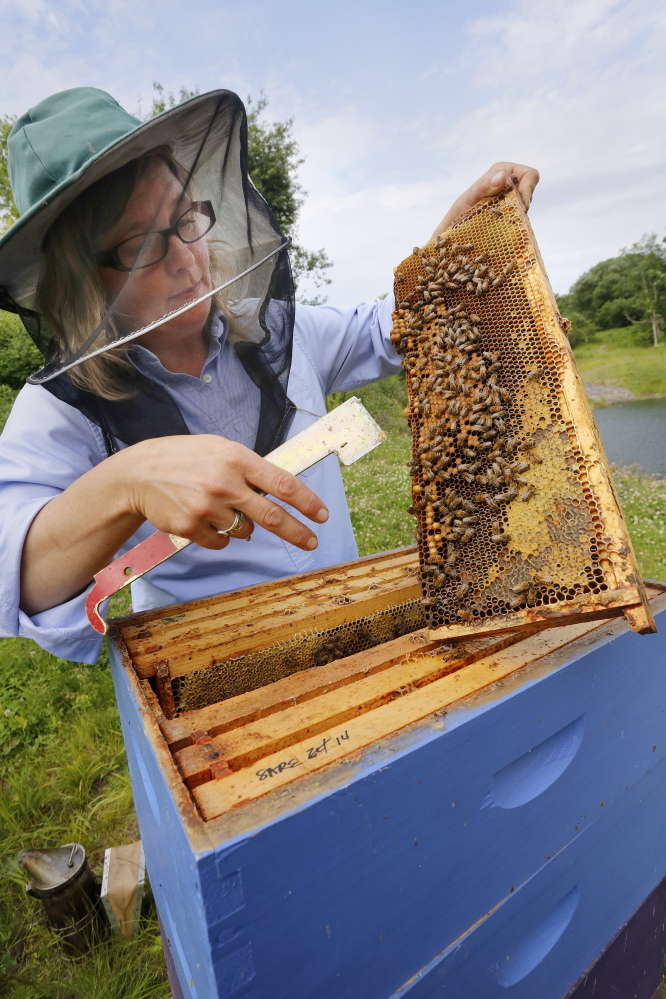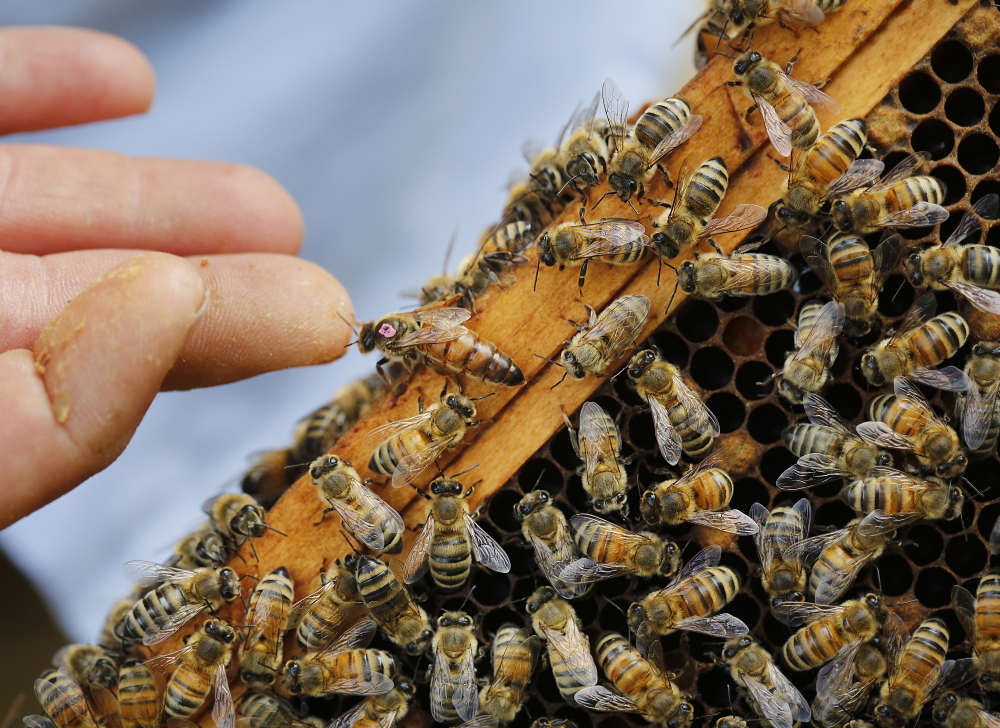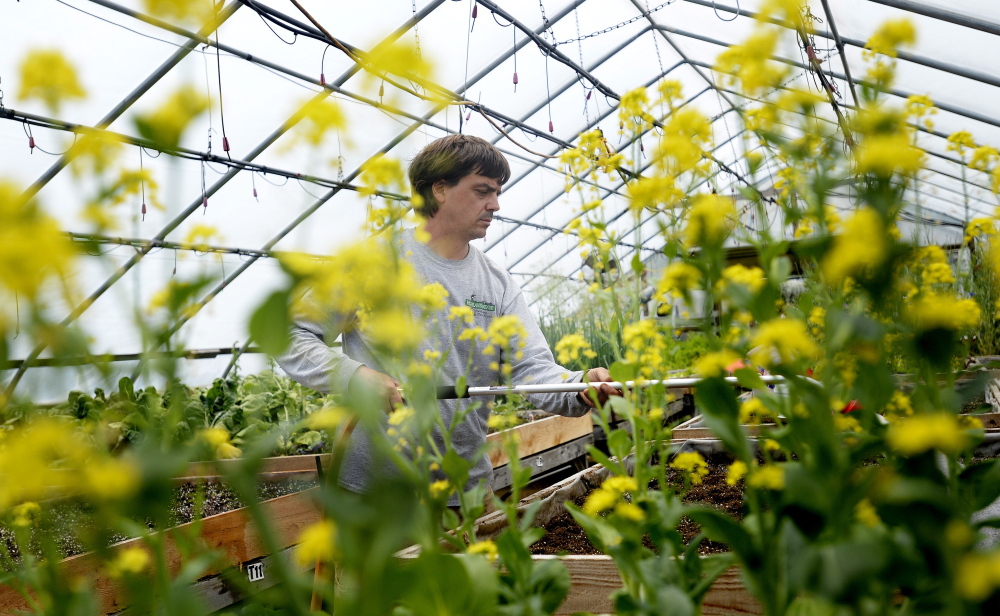A study by the environmental advocacy group Friends of the Earth to be released Wednesday in Portland shows that many home-garden plants, promoted as “bee-friendly,” are pretreated with a class of pesticides that can kill bees and other pollinating insects.
Pesticide test results show that more than half of garden plants from major retailers in 18 cities in the U.S. and Canada, including Portland, contain neonicotinoids, commonly used garden pesticides that are toxic to bees and many other organisms, according to the study.
The results will be made public by representatives of Friends of the Earth and Pesticide Research Institute, along with more than 20 consumer and environmental organizations and beekeeping and organic gardening associations, including Maine Organic Farmers and Gardeners Association. Of plant samples that tested positive for the pesticides, 40 percent contained two or more neonicotinoids.
The result of the widespread use of these pesticides means that many home gardens have likely become a source of harm for bees, the report concluded.
Test samples were gathered by environmental advocates from various organizations, beekeepers and researchers from various universities, said Tiffany Finck Haynes of Friends of the Earth. Testing of the samples was conducted by independent laboratories in each of the study cities in the U.S. and Canada, she said.
In addition, the damaging affects of these pesticides may be far more widespread than first thought, leaving a lasting imprint of injury to birds, mammals, humans and the soil, said a separate report released Tuesday in England, from the Bee Coalition, a collaboration of the main British environmental groups. The study, “Worldwide Integrated Assessment,” reviewed 800 studies from across the globe to create a worldwide profile of the impact of these pesticides on a wide range of invertabrate species in soil, vegetation, aquatic and marine habitats. The authors recommend a significant reduction global phasing out of the neonic pesticides.
GROWING CONCERNS
This week’s reports join a growing body of studies linking neonics with colony collapse disorder, in which honeybees quit their hives for no apparent reason and do not return. A Harvard University study in May focused the collapse of honeybee colonies on neonicotinoids — insecticides that also function as nerve poisons and simulate the effects of nicotine. Scientists specifically examined low doses of two neonicotinoids — imidacloprid and clothianidin — to determine their effects on healthy bee hives over the course of a winter.
The results of the Harvard study supported the conclusion that even sub-lethal exposure to neonicotinoids is probably the main factor causing CCD to occur, the researchers wrote in their paper, published May 9 in the Bulletin of Insectology.
Neonicotinoid pesticides – also referred to as neonics – work by affecting the central nervous system of insects, causing paralysis and death, according to the U.S. Environmental Protection Agency.
The Friends of the Earth study – said to be based on the largest data samples to date – called on major retailers to stop selling plants containing neonics and urged consumers to buy only organic plants instead, to help deter the spread of problems associated with the use of such pesticides, including imidacloprid, a synthetic nicotine.
In addition, the sponsoring organizations are expected to offer homeowners and backyard gardeners tips on how to reduce exposure to the pesticides – known as neonicotinoids – and to protect bees.
Neonicotinoids are systemic pesticides, meaning that they affect not just the surface of leaves of treated plants but also are absorbed through the entire system, penetrating even into the soil, said Erin Forbes, a master beekeeper from Portland. They are persistent, too, lasting up to 15 years in soil, she said, describing neonicotinoids as “the most common class of pesticide mixtures in the world (and) the most common household pesticide.” It is even found in many pet flea collars, Forbes said.
“They are absolutely a contributing factor to the increased decline of honeybee colonies in recent years,” said Forbes. Most plants that are started in soil and transported from one state to another have neonicotinoids in the soil, she said. “Here in Maine that’s the most common route of transmission.”
Neonic pesticides have come under scrutiny in recent years due to the decline of honeybees, particularly from Colony Collapse Disorder. Entomologists and biologists have been working to unravel the multiple factors involved in the disorder, which have decimated bee populations worldwide. The problem has been particularly severe in Europe, where declines of more than 50 percent have been reported in some areas.
The mechanisms of the disorder and the factors in its steady spread remain unclear, but many possible causes have been suggested, including pesticides, particularly neonicotinoids; infections with certain mites; malnutrition; various pathogens; genetic factors; immune deficiencies; habitat loss; changing climate conditions and evolving beekeeping practices. Many scientists believe the disorder is erupting from a combination of these problems.
“There’s a lot of factors in the mix,” said Carol Cottrill of Rumford, president of the Maine State Beekeepers Association.
“Pesticides have always been part of the mix of things affecting pollinators,” Cottrill said. “Neonicotinoids may be part of the problem but they aren’t the whole problem.”
Cottrill praised the new report, calling it “sane and sensible” in its focus on education of homeowners about how to avoid unwitting use of neonics and the need to check on the nursery stock they purchase. “You can buy plants that have not been pretreated,” she said.
GREENHOUSES ON THE WATCH
David LeBlanc, general manager at Longfellow’s Greenhouses in Manchester, said the nursery and garden center began using fewer chemical sprays several years ago, and one reason was concern about effects the sprays have on bees.
“We are probably 90 percent biological control,” LeBlanc said. “We buy good bugs to go after our bad bugs. But if we have a problem that isn’t controllable with our biological program, we have to go in sometimes and spray some material.”
LeBlanc said some of the pesticides they use are neonicotinoids. He said there seems to be scientific disagreement about the cause of declining bee populations, and the evidence against neonicotinoids hasn’t been clear enough to rule out using them.
At Highland Avenue Greenhouse in Scarborough, annual and perennial plants are free of neonicotinoids, because they are not grown in pretreated soil, said Christine Viscone, who co-owns the business with her husband Joe. Consumers concerned about pesticides in plants or soil would benefit from trying local garden centers and asking whether trees and shrubs, in particular – which often are imported from other states to Maine – are treated with neonicotinoids before they buy stock for their own gardens, she said.
“If we can educate people and let them make informed decisions, it will be helpful … better than a ban,” Cottrill said. “If we ban something, I want to know what they’re going to use to replace it. You’ve got to give (people) an alternative. My personal fear is that if they ban the neonics, what are they going to replace them with?”
A proposal to impose a temporary, two-year ban on the sale, distribution and use of neonicotinoid pesticides in Maine failed in the Legislature last year.
Concerns about the risks of neonicotinoids caused Wyman’s of Maine, the nation’s largest producer of wild blueberries, to opt out of use of the pesticides altogether on its 10,000 acres of berries, said Ed Flanagan, the company’s president and CEO.
“We have never used them,” Flanagan said. Beekeepers at Wyman’s – one of whom, David Hackenberg, is credited as being among the early detectors of Colony Collapse Disorder in 2006 – expressed suspicions about the toxic effects of the pesticides, which weaken bees’ immune systems. The decision was made early on to seek other alternatives, Flanagan said.
Last Friday, the White House issued a statement calling the decline of honeybees, native bees and other pollinators – including birds, bats and butterflies – a serious problem that “poses a significant challenge that needs to be addressed to ensure the sustainability of our food production systems, avoid additional economic impacts on the agricultural sector and protect the health of the environment.”
President Barack Obama called for several measures, including the establishment of a task force charged with developing a national strategy to improve pollinator health.
The White House stopped short of singling out neonicotinoid pesticides but included “pesticide exposure” as one of several factors in bee decline.
Pollinators contribute more than $24 billion to the U.S. economy annually – with honeybees accounting for more than $15 billion, according to the White House statement.
“Honeybees enable the production of at least 90 percent of commercially grown crops in North America,” the statement said. Globally, animal pollinators enable the production of 87 of the leading 115 food crops, the White House estimated.
According to the Food and Agriculture Organization of the United Nations, shortages of bees in the U.S. have increased the cost to farmers renting them for pollination services by up to 20 percent.
Kennebec Journal writer Susan McMillan contributed to this story.
Send questions/comments to the editors.





Success. Please wait for the page to reload. If the page does not reload within 5 seconds, please refresh the page.
Enter your email and password to access comments.
Hi, to comment on stories you must . This profile is in addition to your subscription and website login.
Already have a commenting profile? .
Invalid username/password.
Please check your email to confirm and complete your registration.
Only subscribers are eligible to post comments. Please subscribe or login first for digital access. Here’s why.
Use the form below to reset your password. When you've submitted your account email, we will send an email with a reset code.